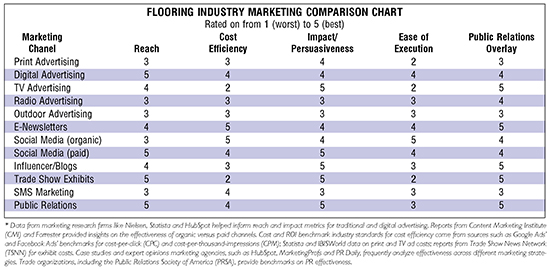Marketing Minute: The case for advertising, part two – April 2025
By Paul Friederichsen
In my April 2020 Marketing Minute, I addressed “The Case for Advertising,” because at that time-as is still the case today-its importance is sometimes questioned. Advertising has been around for thousands of years, and with today’s barrage of content and countless business options, there is no question that advertising in some form or fashion is needed to capture consumers’ attention and stand out from the crowd. The questions for the flooring marketer, then, are as follows: Which media channel(s) work best to get the job done? How do they get the job done in measurable terms of accountability (reach and cost)? How do they create impact and persuasive power? And how easy is the advertising to execute and produce?

ASSESSING THE OPTIONS
Unlike the old Madison Avenue days, there are numerous alternative media channels in the digital age that marketers can enlist to support their brand or promotion. From AI research*, here is a comparison of common media selections often used by B2B and B2C flooring marketers, with 1-5 rankings for each regarding reach, cost, etc. The B2B sector typically favors high-trust, high-touch marketing methods (PR, trade shows, email), while B2C channels tend to focus on mass reach and quick impact (TV, digital ads, social media).
Digital advertising and paid social media (ads) have the highest scores across the board, and that’s where much of the budgets are going nowadays. Print advertising scored lower when compared to digital reach; however, print media in the flooring trade is essential. In addition to other attributes, print provides pass-along value and longer time spent on content (five versus 20 minutes).
PR becomes a booster for everything by going further to shape brand perception and credibility and to extend reach organically. Editorial content-which PR operates with-has more credibility than ads. As PR folks are fond of saying, “If ads get you ten miles to the gallon, PR will get you 50.”
CRAFTING A MULTI-CHANNEL MEDIA STRATEGY
It’s not the individual ingredients that make a masterpiece; it’s how they’re blended that counts. If you observe flooring brands, you’ll notice different multi-channel media strategies at work, since no single channel or vehicle will do the job. These strategies maximize reach, frequency and engagement by leveraging multiple media vehicles that complement each other and are particularly useful for smaller brands to project a much larger image or to facilitate a call to action. Here are a few examples among many:
• Cross-media targeting uses customer data (demographics, behaviors, interests) to serve ads across different media that share overlapping audiences.
Example: A person who sees a flooring ad on Instagram may also get served a similar ad on a home improvement website.
• Sequential messaging uses different media vehicles to tell a brand story in phases, reinforcing the message.
Example: A flooring company runs an awareness-building print ad, followed by a digital remarketing campaign with a call to action.
• Hyper-local targeting uses geotargeting and geofencing to reach customers in specific locations.
Example: A flooring company advertises on billboards in key markets while serving digital ads to people within a certain radius.
Never minimize the importance of good creative. Ads, on average, have about two to three seconds to get attention in a magazine and compel further interest. A recent article in Branding Strategy Insider entitled “The Formula for Iconic Advertising Campaigns” provides an important perspective on what’s really needed: emotion, simplicity and storytelling. Even if your brand isn’t “iconic,” your campaign can be.
THINGS TO KEEP IN MIND
Too often, marketers select media channels and individual vehicles purely based on numbers or claims that cannot be validated. Circulation numbers, traffic or viewership only tell part of the story. Check the audit. Ask questions. Spend your company’s or client’s money as if it were your own, without fear or favor. SimilarWeb is a useful comparison tool for websites and blogs. BPA Worldwide is a legitimate circulation audit service. Nielsen provides comprehensive data on TV viewership. Monitor your own social media performance and constantly adjust.
Platforms like Facebook, Instagram and LinkedIn have become a poor substitute as a free advertising medium. Translation: They want you to pay for the privilege of posting for free by diminishing the organic reach of your posts. Facebook is the worst, with an average reach of 2.6% per organic post for every 1,000 followers. Instagram averages 4%, but that’s an 18% year-over-year decrease, according to sources. LinkedIn gives you about 3.84% per 1,000 followers and has dropped to about one third of its previous levels.
Assume you have 5,000 followers, and you want to reach a modest 50% of them with a post. You’ll need to spend between $10 and $20 per post. If you’re running all three platforms with two to three posts per week, it can add up fast. Of course, quality, relevancy, seasonality, competition, diversity and engagement can affect outcomes, so every well-designed, well-written post matters in terms of consistency, production value and storytelling.
Social media is still powerful, if not essential, for brands; just don’t expect too much if you’re using it like you would a paid print or digital ad. Make your social media truly social by encouraging your staff and management to regularly engage, comment and share. The platforms will reward your efforts and extend your reach.
Copyright 2025 Floor Focus
Related Topics:RD Weis
